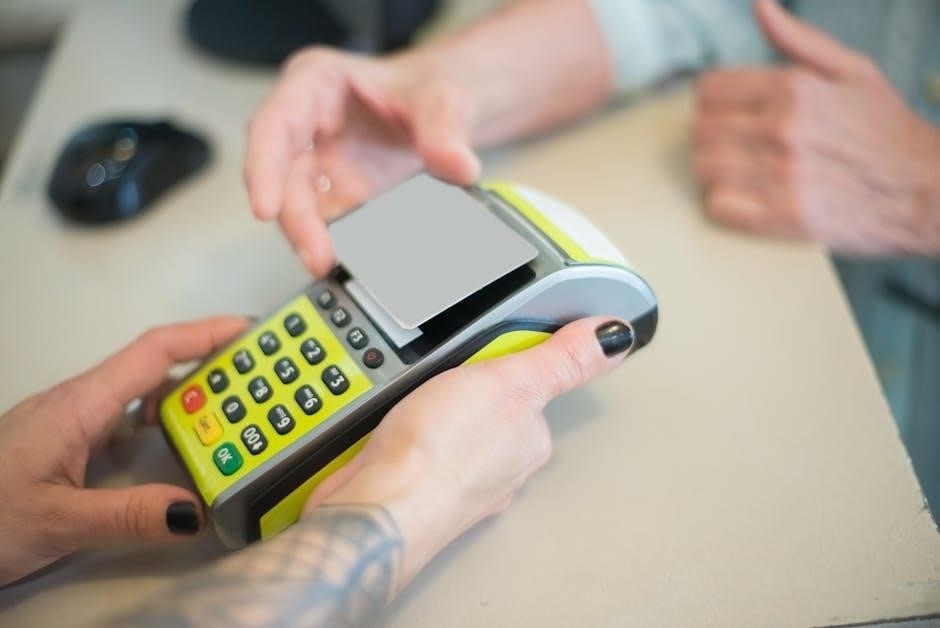Credit card processing enables businesses to accept card payments securely, streamlining transactions and enhancing customer satisfaction. It is a cornerstone of modern commerce, ensuring efficient and reliable payment solutions.
1.1 What is Credit Card Processing?
Credit card processing is the system enabling businesses to accept and process card payments securely. It involves payment terminals, software, and networks facilitating transactions between merchants, banks, and cardholders. This process ensures funds are transferred from customers to businesses efficiently, supporting both in-person and online sales while maintaining security and compliance standards to protect sensitive data and prevent fraud.
1.2 Why Credit Card Processing is Essential for Businesses
Credit card processing is vital for businesses as it meets customer payment preferences, enhances sales opportunities, and streamlines transactions. It ensures faster settlement, improves cash flow, and reduces reliance on cash handling. Additionally, it supports scalability, allowing businesses to grow and adapt to evolving payment trends while maintaining security and customer trust, ultimately driving long-term success in a competitive marketplace.

How Credit Card Processing Works
Credit card processing involves payment terminals, POS systems, and secure networks to facilitate transactions. It ensures quick and reliable payment authorization, settlement, and fund transfers, enhancing business efficiency and customer satisfaction with advanced security measures like EMV technology to protect sensitive data, making it an essential tool for modern commerce.
2.1 The Role of Payment Terminals and POS Systems
Payment terminals and POS systems are essential for accepting credit and debit card payments. They enable businesses to process transactions securely, whether in-person or online. Countertop terminals are stationary, while mobile devices offer flexibility for on-the-go payments. Integrated POS systems combine payment processing with inventory management and sales tracking, streamlining operations. These tools ensure quick authorization, settlement, and fund transfers, enhancing efficiency and customer satisfaction with advanced security features like EMV technology.
- Countertop terminals are ideal for fixed checkout counters.
- Mobile devices support payments anywhere, improving customer convenience.
- Integrated POS systems offer comprehensive business management solutions.
2.2 The Payment Processing Lifecycle: Authorization to Settlement
The payment processing lifecycle begins with authorization, where the card issuer verifies funds. If approved, the transaction is captured and batched. Settlement occurs when funds are transferred to the merchant’s account. This seamless process ensures secure, efficient, and timely payments, with advanced security measures like PCI compliance and encryption protecting sensitive data throughout the cycle.
- Authorization confirms card validity and sufficient funds.
- Batch submission processes multiple transactions at once.
- Settlement finalizes fund transfers to the merchant.
Understanding Credit Card Processing Fees
Credit card processing fees include interchange, assessment, and markup charges, impacting businesses. Understanding these fees helps optimize costs and improve financial efficiency for merchants.
3.1 Types of Fees: Interchange, Assessment, and Markup Fees
Credit card processing fees include interchange fees, set by card networks like Visa and Mastercard, assessment fees from card brands, and markup fees added by processors. These fees vary based on factors like card type and transaction method. Understanding each fee type helps businesses optimize their payment processing costs and negotiate better rates with providers. Transparent pricing models ensure clarity for merchants.
3.2 How to Optimize Your Business Costs
To optimize credit card processing costs, negotiate rates with providers, consider flat-rate pricing, and pass fees to customers when possible. Implementing efficient POS systems reduces manual errors and speeds up transactions. Regularly review statements to identify unnecessary charges and ensure transparency in pricing models. These strategies help businesses streamline operations and minimize expenses associated with payment processing.

Payment Terminals and Hardware
Payment terminals are devices enabling businesses to accept credit and debit card payments. They come as countertop, mobile, or integrated POS systems, enhancing transaction security and speed.
4.1 Types of Payment Terminals: Countertop, Mobile, and Integrated POS
Payment terminals include countertop devices for fixed locations, mobile options for on-the-go transactions, and integrated POS systems for seamless business management. Each type enhances payment efficiency and security.
4.2 Best Practices for Choosing the Right Hardware
When selecting payment hardware, assess your business needs for scalability and functionality. Prioritize devices with EMV and contactless payment capabilities for security. Ensure compatibility with your POS system and software. Opt for user-friendly interfaces and durable designs. Consider future-proof technology to avoid frequent upgrades. Check for robust customer support and warranty options to maintain smooth operations. These steps ensure a seamless and efficient payment experience for your business.

Security and Compliance in Credit Card Processing
Security and compliance are critical to protecting sensitive data and ensuring trust in transactions. Adhering to industry standards safeguards businesses and customers from fraud and breaches.
5.1 Understanding PCI DSS Compliance
PCI DSS (Payment Card Industry Data Security Standard) ensures businesses securely handle cardholder data. It outlines requirements like encryption, firewalls, and access controls. Compliance is mandatory for all merchants, with four levels based on transaction volume; Regular audits and assessments verify adherence. Non-compliance risks penalties and data breaches, undermining customer trust. Achieving PCI DSS certification demonstrates commitment to safeguarding sensitive information and maintaining industry security standards.
5.2 Protecting Customer Data from Fraud and Breaches
Protecting customer data is critical to prevent fraud and breaches. Encryption, tokenization, and secure payment gateways safeguard sensitive information. Regular security audits and employee training reduce vulnerabilities. Implementing firewalls and access controls further enhances protection. Businesses must also monitor transactions for suspicious activity and maintain compliance with industry standards to minimize risks and ensure customer trust in payment processing systems.
Chargebacks and Disputes
Chargebacks occur when customers dispute transactions, often due to unauthorized charges or service issues. They can harm a business’s reputation and financial health. Understanding the causes and implementing preventive strategies is crucial for minimizing disputes and maintaining customer trust in payment processing systems.
6.1 Preventing Chargebacks: Tips and Strategies
Preventing chargebacks requires clear communication, thorough documentation, and proactive monitoring. Ensure transaction descriptions are detailed, verify cardholder information, and obtain signatures or authorization. Provide excellent customer service to resolve issues before disputes arise. Implement a refund or return policy and monitor transactions for suspicious activity. Regularly updating payment records and maintaining open lines of communication with customers can significantly reduce chargeback occurrences and protect your business reputation.
6.2 How to Manage and Respond to Chargeback Disputes
When managing chargeback disputes, review the case thoroughly and gather evidence to support your position. Respond promptly within the required timeframe, typically 7-10 days, with clear documentation. Provide detailed records, such as receipts, authorizations, and communication logs. Address the specific reason for the dispute and explain how it was resolved or why the charge is valid. Maintain professionalism and transparency to ensure a fair resolution and minimize financial impact.

Choosing the Right Credit Card Processing Provider
Selecting the right credit card processing provider is vital for seamless transactions, security, and cost-efficiency. Consider factors like pricing, security features, ease of use, and customer support to find a provider that aligns with your business needs and ensures reliable payment processing.
7.1 Key Factors to Consider When Selecting a Provider
When choosing a credit card processing provider, evaluate transaction fees, security features, and integration compatibility. Consider the provider’s reputation, customer support, and transparency in pricing. Assess whether they offer scalability for business growth and support for various payment methods. Additionally, check for compliance with industry standards like PCI DSS to ensure data protection. These factors will help you select a provider that aligns with your business needs and ensures seamless payment processing.
7.2 How to Compare Providers and Their Services
Compare providers by evaluating their pricing models, contract terms, and customer support. Assess their technology compatibility with your POS system and ability to handle various payment methods. Consider industry-specific solutions and additional features like fraud prevention tools. Consider user reviews and ask about scalability options to ensure they can grow with your business. This thorough comparison ensures you select a provider that meets your specific needs and enhances your payment processing efficiency.

Credit Card Processing Technology and Trends
Credit card processing technology is evolving rapidly, embracing innovations like EMV, contactless payments, and mobile wallets. Emerging trends include AI-driven fraud detection and blockchain for secure transactions.
8.1 The Rise of EMV and Contactless Payments
The shift to EMV technology has enhanced security, reducing fraud with chip-based cards. Contactless payments, using NFC, offer convenience, speeding up transactions without physical contact. These trends are reshaping the payment landscape, prioritizing both security and user experience, driving a future where seamless, high-tech payment methods dominate global commerce.
8.2 Future Trends: AI, Blockchain, and Mobile Payments
Emerging technologies like AI, blockchain, and mobile payments are transforming credit card processing. AI enhances fraud detection and personalizes payment experiences. Blockchain ensures secure, transparent transactions, reducing fraud risks. Mobile payments, powered by NFC and digital wallets, are increasingly popular, offering convenience and speed. These innovations promise faster, safer, and more seamless payment solutions, shaping the future of global commerce. Businesses must adapt to remain competitive in this evolving landscape.

Credit Card Processing for Small Businesses
Credit card processing empowers small businesses to streamline transactions, offering modern payment solutions that enhance efficiency and scalability while remaining affordable and accessible.
9.1 Simplifying Credit Card Processing for Small Business Owners
Credit card processing can be streamlined for small businesses through user-friendly tools and clear fee structures. By selecting the right payment terminals and software, owners can reduce complexity and focus on growth. Understanding interchange fees and chargeback prevention strategies helps optimize costs. Additionally, industry-specific solutions provide tailored support, ensuring seamless transactions and enhanced customer satisfaction. This approach makes payment processing accessible and efficient for businesses of all sizes.
9.2 Industry-Specific Solutions for Small Businesses
Small businesses in retail, food service, and e-commerce benefit from tailored credit card processing solutions. These solutions address unique needs, such as online ordering systems for restaurants or appointment booking for salons. Industry-specific tools reduce errors and streamline workflows, ensuring seamless transactions. Features like inventory management integration or recurring payments cater to niche requirements, helping businesses adapt and thrive in their respective markets.
Common Questions and Answers
This section addresses common concerns about credit card processing, such as chargebacks, security, and provider selection. It clarifies key topics, offering clear insights and practical advice.
10.1 Addressing Common Concerns and Misconceptions
Common concerns include chargebacks, security risks, and fee structures. Misconceptions often revolve around the complexity of payment processing. Addressing these involves understanding chargeback prevention strategies, security measures like encryption, and fee optimization. Businesses must also balance convenience with compliance, ensuring seamless transactions while adhering to regulations like PCI DSS. Clarifying these points helps businesses make informed decisions, fostering trust and efficiency in their payment systems.
10.2 Frequently Asked Questions About Credit Card Processing
Common questions include how processing fees are calculated, the difference between interchange and markup fees, and the best ways to prevent chargebacks. Businesses also inquire about EMV compliance, contactless payments, and integrating payment systems with existing POS solutions. Additionally, questions often arise about selecting the right provider, understanding PCI DSS requirements, and optimizing payment security to protect customer data and prevent fraud.
